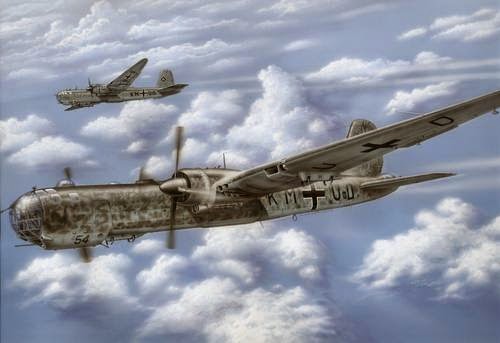The Do 17E and Do 17F gave way to the
broadly similar Do 17M and Do 17P, which were bomber and reconnaissance
variants respectively, differing from the earlier versions in being powered by
900 hp Bramo Fafnir 323A or BMW 132N radial engines in place of the inline DB600s
originally fitted. These raised the maximum speed to fractionally above 300
mph. The DB600-powered versions remained in limited use at the beginning of the
war, but by the Battle of France all had vanished from frontline service. On 10
May, 188 serviceable Do 17Ms and Do 17Ps were available, together with 338
examples of the further improved Do 17Z.
Production Do 17Zs featured more powerful
(1,000 hp) Bramo 232P radial engines with two-stage superchargers, but more
obviously had an entirely redesigned forward fuselage, much deeper, more
extensively glazed, and with a huge underslung ventral gondola. This had first
appeared on the Do 17S (built in pre-production form only) and made the
aircraft look much more like a Ju 88. It raised the crew complement to five,
though the bombload remained a paltry 22001b. Defensive armament was increased
to six 7.9-mm machine guns, one fixed and one free-mounted firing forward, one
firing aft in each of the dorsal and ventral positions, and two in the side
windows. But these weapons were mounted singly, and had relatively limited arcs
of fire. By comparison with the multi-gun powered turrets fitted to aircraft
like the Wellington and Blenheim they represented little more than a last-ditch
defence, although Do 17 gunners did down surprising numbers of RAF fighters
which pressed their attacks too closely, or failed to break away aggressively
enough. The Do 17U was basically a hybrid combining the new nose with the
engines of the Do 17M. The 15 aircraft built were used as dedicated pathfinders
by Kampfgrüppe 100, and carried
a second radio operator.
The Dornier Do 17 was the least numerous of
the Luftwaffe bombers deployed against Britain during the Battle, but has been
claimed by some to have been the most effective. Most German military aircraft
of the period were designed from the start as warplanes, but were first
revealed in a civil guise - masquerading as airliners or 'high speed
mailplanes'. For example, Dornier itself had built Do 11Cs in Switzerland as
'freight transports'. The Do 17, by contrast, was really designed as a high
speed mailplane, with tiny cramped cabins fore and aft of the wing
accommodating six passengers with very difficult access. This was realised too
late, and the three prototypes were soon placed in storage, where they remained
until discovered by a curious RLM test pilot, who flight-tested one and was so
impressed by its performance that he suggested the type's conversion for use as
a high-speed bomber.
Dornier were by then working on the
long-range Do 19, a four-engined heavy bomber, and were not greatly interested
in the idea. Nor, until the death of General Walther Wever, was the Luftwaffe.
But Wever's successor as Chief of Staff, Albert Kesselring was a tactical man,
through and through, and preferred large fleets of relatively cheap,
lightweight bombers optimised for what was, in essence, a close support role.
The Do 17 soon won his approval, while the Do 19 (probably the aircraft the
Luftwaffe really needed for the Battle of Britain) was unceremoniously
scrapped. Three further Do 17 prototypes were built with twin endplate fins in
place of the original aircraft's single fin, and the forward fuselage was
deepened and fitted with extensive glazing to accommodate a full bomber crew.
The aircraft retained much of the appearance of the original, and this led to
the type's 'Flying Pencil' nickname.
Aircraft losses suffered during the
invasion of the Low Countries and France were not fully restored, while some
units were already converting to the newer, faster and more effective Ju 88. Do
17 numbers dropped throughout the Battle of Britain. On 1 September 1940, the
frontline bomber Kampfgrüppen had 158 Do 17Ms and 212 Do 172s on charge. These
won a reputation for low level pinpoint bombing attacks, but also flew their
share of medium level area attacks. The Do 17 was highly manoeuvrable, and its
crews could dive at speeds which bordered on the unbelievable. If sufficient
height were available, and the defending fighters low on fuel, Dorniers could
sometimes escape by pushing their noses down and diving for home 'flat out' -
much like the Ju 88. A final version of the 'Flying Pencil' in use during the
Battle of Britain was the Do 215B, 18 of which were designed and built for
export (to Sweden) but were then embargoed and re-directed to the Luftwaffe,
which used them for reconnaissance duties.










